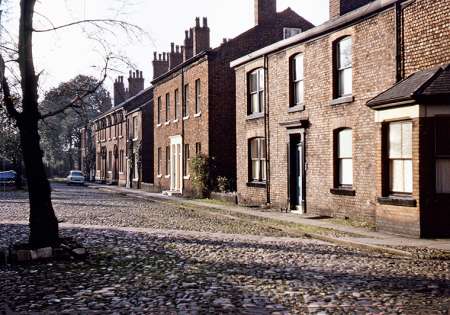Moravian Settlement, Fairfield
In the eighteenth century some Moravian congregations were established as Settlements where the members might live and follow their private vocations as members of a disciplined Christian Brotherhood. The last such settlement to be built was at Fairfield, established in 1785. It formed a self-contained and self-sufficient community which, being situated so close to the areas of rapidly expanding industry round Manchester, generated considerable local interest and attracted a stream of visitors in its early years. The Moravian settlements certainly influenced nineteenth century social reformers and perhaps Fairfield influenced the more socially minded of the mill owners in the Manchester area who, a few years later were tempted to form communities round their mills.
The Moravians had opened their first English church in Fetter Lane. London on 10 November 1742 and a year later, a Moravian community had also been established at Dukinfield. However, the land was held on lease and in 1779 Bishop Watteville bought a 53-acre farm at Droylsden. Joseph Saxon and his family were the first to move to the farm and brick kilns were built. On 9 June 1784 Benjamin Latrobe laid the foundation stone of the chapel and choir house. By May 1785 the chapel and thirteen (later seventeen) houses had been completed at a cost of £6,000. In addition, some members of the community built their own houses. The community comprises a total of 110 communicant members, 22 single brethren and 45 single sisters. It remains the largest settlement of its kind in Britain and is possibly the most important group of eighteenth-century secular buildings in east Manchester. Shortly after the settlement was founded John Aitkin described it in the following terms:
Fairfield is a new settlement belonging to the Moravians, near four miles from Manchester and within two fields of the Ashton turnpike road. Though established within these twenty years it has the appearance of a little town. There is a large and commodious chapel, with an excellent organ. The ground plot is laid out with great taste and judgement. It forms a large square. The chapel and some large dwelling houses well-built of brick form the front. On each side of the chapel is a row of elegant large houses. These, with the chapel, form a large square mass of buildings, round which is a broad paved street, and the whole is flagged round. On the outer side of the street is another row of excellent buildings, which surrounds the whole, except the front; at a short distance from which is a fine row of kitchen gardens, and opposite to the chapel a large burying ground; the whole divided and surrounded with quickset hedges. One of the houses is a convenient inn with stabling, etc, for the accommodation of those who frequent the place. The neatness of the whole has a very pleasing appearance, and the place is frequented by numbers from Manchester.... The cotton manufacture forms a principal part of the employment of the inhabitants, including spinning, weaving, etc., Tambour and fine needlework is carried out to a great pitch of perfection and is chiefly sent to London; there is also in this settlement tailors shoemakers, bakers and a sale shop for most articles, as well as for the convenience of the settlement as the neighbourhood. The Manchester, Ashton and Oldham Canal (completed 1794) comes close to this place, which will be of infinite advantage to it as well as for the carrying of goods to and from Manchester and Ashton, as for procuring a supply of coals nearly as cheap as at the port. [J Aikin 1795, 232].
Reference W H G Armytage: Heavens Below: Utopian Experiments in England 1560-1960. Routledge 1961
Reference J. Aitkin: “A Description of the Country from 30 to 40 miles around Manchester”. 1795. Page 232-3
Reference Gillian Darley: Villages of Vision 1975
